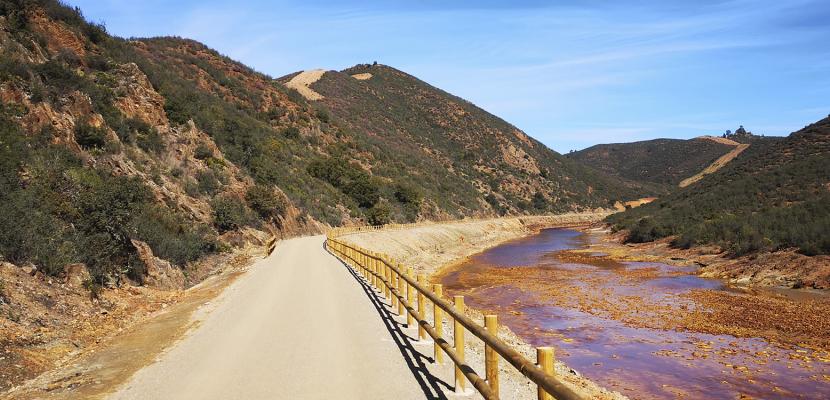Image

Camino del Río Tinto
Published on 01 April 2020

Spain
Andalucía
This is the good practice's implementation level. It can be national, regional or local.
About this good practice
The aim of this practice is to transform the Río Tinto Natural Pathway into a cyclable route of 102 km. The route will run through a unique landscape, alongside the river and crossing 14 municipalities, from the source of the river in "La Peña del Hierro" to the remarkable endpoint "Muelle de la Rio Tinto Company Limited".
The first 5.5 km part of the route was recently completed with an investment of close to 400,000 euros provided by County Council of Huelva. The works were planned in 3 stages, comprising railway dismantling, ground improvement, the restoration of two bridges, signposting and ancillary items to provide useful safety and tourist information for bike users.
There are available funds for 400,000 euros plus a preliminary agreement of additional 1.300.000 euros, to keep works and technical consultancies in progress during 2019-2020. Conversations are ongoing with different public bodies such as the Regional Ministry of Andalusia or the Ministry of Agriculture, Fisheries and Food through the Natural Trails Programme (Programa Caminos Naturales), looking for possible funding for the rest of the route infrastructure. Besides the entities above mentioned there have been stakeholders involved as Fundación Río Tinto which aims to preserve and restore historical and natural heritage linked to mining, and Ferrocarriles Españoles, which works to convert disused railway lines into cycling routes through the Vias Verdes Programme (Greenways Programme)
The first 5.5 km part of the route was recently completed with an investment of close to 400,000 euros provided by County Council of Huelva. The works were planned in 3 stages, comprising railway dismantling, ground improvement, the restoration of two bridges, signposting and ancillary items to provide useful safety and tourist information for bike users.
There are available funds for 400,000 euros plus a preliminary agreement of additional 1.300.000 euros, to keep works and technical consultancies in progress during 2019-2020. Conversations are ongoing with different public bodies such as the Regional Ministry of Andalusia or the Ministry of Agriculture, Fisheries and Food through the Natural Trails Programme (Programa Caminos Naturales), looking for possible funding for the rest of the route infrastructure. Besides the entities above mentioned there have been stakeholders involved as Fundación Río Tinto which aims to preserve and restore historical and natural heritage linked to mining, and Ferrocarriles Españoles, which works to convert disused railway lines into cycling routes through the Vias Verdes Programme (Greenways Programme)
Expert opinion
The practice is about the transformation of a natural pathway along a river into a cycling route passing through 14 municipalities. The ambitious project is still under implementation, but the overall concept for revitalising a former mining area, which is in a degraded condition, can provide helpful insight to other regions to launch similar initiatives. What can be inspiring for other public bodies is that the project is implemented with the goal to preserve and restore historical and natural heritage linked to mining, and institutions in charge of heritage protection have been involved in the project development. The question of funding can be also of interest as funding from different sources (e.g. local, regional, etc.) has been used to support the activities.
Resources needed
It is foreseen estimated funding of €10m. The complexity of the route requires an in-depth technical analysis as the layout runs in parallel to a railroad track demanding additional costly infrastructure. Maintenance will lay on County Council through technical departments and their staff.
Evidence of success
The process started in 2018-2019 with a 5.5 km long recovering pilot project funded by a 400,000 euros investment from Diputación de Huelva. A technical project to recover part of the line with an estimated reference budget of €10m is under evaluation, involving costly bridges or tunnel restorations and heritage facilities remaining alongside the track.
Potential for learning or transfer
The relevance of heritage items potentially affected by such an activity close to the railway has to be an aggregated intervention and may require above-average levels of funding. It involves diverse public bodies in an itinerary to ensure successful development, supported by a provincial bicycle plan (under development). This is an excellent example of an intervention in degraded areas due to the mining activity which took place through centuries and that today, after their disappearance, suffers depopulation and underemployment despite the rich historical heritage linked to those heavy industry activities. This practice can be exported to extensive areas all over Europe with similar conditions because of the decay of mining industry and therefore could be inspiring for public authorities to design and develop specific funding tools for cycling in natural degraded or rural deprived areas, involving from the local to the national level and supported by the corresponding planning.
Further information
Website
Good practice owner
You can contact the good practice owner below for more detailed information.
Organisation
County Council of Huelva (Diputación Provincial de Huelva)

Spain
Andalucía
Contact
European Project Manager